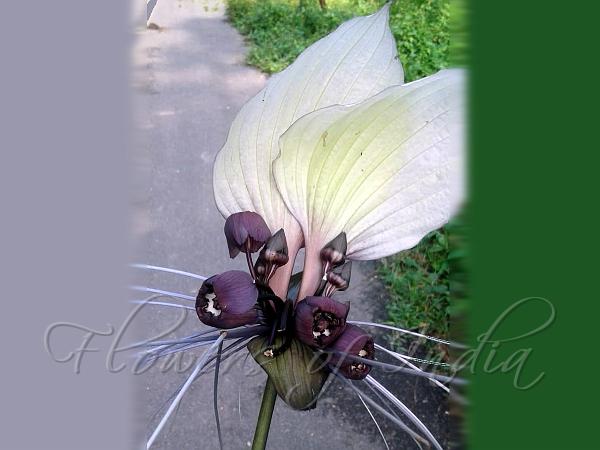|
| White Bat Flower |
|

|

|
|
|
|
Photo: |
Botanical name: Tacca integrifolia Family: Dioscoreaceae (Yam family)
Synonyms: Tacca laevis, Tacca aspera, Tacca cristata
Synonyms: Tacca laevis, Tacca aspera, Tacca cristata
White Bat Flower is a herb growing from a thick,
cylindrical rhizome. The leaf blades are carried on long stalks and are
oblong-elliptical to oblong-lanceshaped, 50-20 cm, with tapering bases
and slender pointed tips. The flowering stem is about 55 cm long and is
topped with a pair of involucral bracts, broad and erect, white with
mauve venation. Among the individual nodding flowers, which are
arranged in an umbel, are further long, thread-like bracts. The
perianth of each flower is tubular and purplish-black, 1-2 cm long,
with two whorls of three tepals, the outer three narrowly oblong and
the inner three broadly obovate. The fruits are fleshy berries about 2
cm long, and the seeds, which have six longitudinal ridges, have the
remains of the tepals still attached. White Bat Flower is found in
mountain forests in Eastern Himalayas, at altitudes of 800-900 m. It is
found in Bangladesh, Bhutan, Cambodia, NE India, Indonesia, Laos, W
Malaysia, Myanmar, Pakistan, Sri Lanka, Thailand, Vietnam.
Medicinal uses: Rhizomes are used in
Traditonal Chinese Medicine to treat gastric ulcers, burns and high
blood pressure and burns, as well as improve sexual functioning. In
Malaysia, rhizome paste is applied to treat skin rash caused by hairy
stinging caterpillars, and onto wounds or heel cracks. Pounded berries
are mixed with water and drunk to treat dystentery and stomachaches.
Leaf decoction is taken orally with salt for bloody dysentery and acute
diarrhoea. Overdosing results in toxicity.
Rhizomes are used in
Traditonal Chinese Medicine to treat gastric ulcers, burns and high
blood pressure and burns, as well as improve sexual functioning. In
Malaysia, rhizome paste is applied to treat skin rash caused by hairy
stinging caterpillars, and onto wounds or heel cracks. Pounded berries
are mixed with water and drunk to treat dystentery and stomachaches.
Leaf decoction is taken orally with salt for bloody dysentery and acute
diarrhoea. Overdosing results in toxicity.
Medicinal uses:
 Rhizomes are used in
Traditonal Chinese Medicine to treat gastric ulcers, burns and high
blood pressure and burns, as well as improve sexual functioning. In
Malaysia, rhizome paste is applied to treat skin rash caused by hairy
stinging caterpillars, and onto wounds or heel cracks. Pounded berries
are mixed with water and drunk to treat dystentery and stomachaches.
Leaf decoction is taken orally with salt for bloody dysentery and acute
diarrhoea. Overdosing results in toxicity.
Rhizomes are used in
Traditonal Chinese Medicine to treat gastric ulcers, burns and high
blood pressure and burns, as well as improve sexual functioning. In
Malaysia, rhizome paste is applied to treat skin rash caused by hairy
stinging caterpillars, and onto wounds or heel cracks. Pounded berries
are mixed with water and drunk to treat dystentery and stomachaches.
Leaf decoction is taken orally with salt for bloody dysentery and acute
diarrhoea. Overdosing results in toxicity. | Identification credit: Tabish | Photographed in Arunachal Pradesh. |
• Is this flower misidentified? If yes,